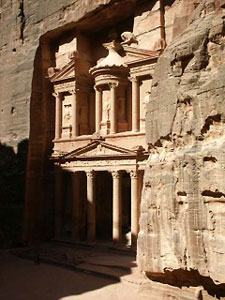Weekly Reports from Jordan
Choose Year: or Choose week
June 26-July 2, 2004
Larry G. Herr and Douglas R. Clark
The first full week of the 2004 Umayri dig is history. We are covered with dust and glory and we are beginning to realize some of the goals we had set for ourselves at the start of the season. There has been very little sickness and, so far, only minor bits of trauma.
The worst two events were experienced by Myron Widmer and Mary Boyd. Myron turned over a large stone in his square and a snake hissed at him. Needless to say the stone went back into place with quick dispatch and the workers dispatched the snake within seconds of its discovery. Back in camp the Reverend Mary Boyd tripped on an irregular spot in the sidewalk and crashed to the cement on her nose and forehead. Our first-aid person, Andrew Curtis, patched her up temporarily, but she needed a few stitches in her forehead at the emergency room at the Fifth Circle Hospital and, wherever she has gone, has been preceded by a red-stained nose for the last few days. As her co-field supervisor David Hopkins later stated, "Mary is obviously working much too hard, toiling endlessly with her nose to the grindstone." Mary, herself, would rather see the results in terms of Proverbs 31, the biblical passage on the valiant woman that she studied for her doctoral dissertation, when it states, "Charm is deceitful and beauty is vain."
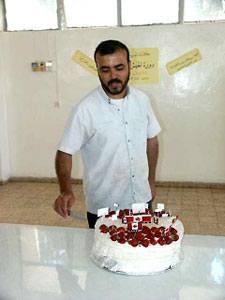 Thursday, July 1, was Canada Day and our 10 hardy Canadians wished Canada a happy birthday by sharing a red-and-white cake at lunch prepared by the inimitable chef Muhammad (who later confessed it was his first western-style cake-it tasted great) and sang the national anthem. Afterwards, we all felt like we ought to drop the puck and play a game of hockey. If only the weather were sufficiently cool for hockey! The Fourth of July will find us, Canadians and Americans alike, hiking in Petra.
Thursday, July 1, was Canada Day and our 10 hardy Canadians wished Canada a happy birthday by sharing a red-and-white cake at lunch prepared by the inimitable chef Muhammad (who later confessed it was his first western-style cake-it tasted great) and sang the national anthem. Afterwards, we all felt like we ought to drop the puck and play a game of hockey. If only the weather were sufficiently cool for hockey! The Fourth of July will find us, Canadians and Americans alike, hiking in Petra.
On Sunday afternoon we took a tour of Amman, visiting the Roman sites downtown, including the huge theatre climbing up a steep cliff, the much smaller theatre called the Odeon, and the nymphaeum-a huge construction for water play and statues. We drove by Ain Ghazal, one of the largest Stone Age sites in the Holy Land and then visited the Amman Archaeological Museum on top of the ancient walled capital city of the Ammonites. This stop also included the large temple to 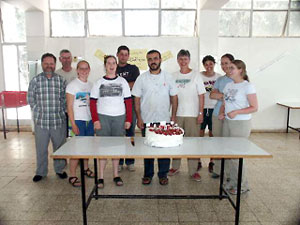 Hercules and a spectacular Umayyad (the earliest caliphate with its capital in Damascus) palace dating to about AD 650. We next went to the King Abdullah Mosque (also called the Blue Mosque-not to be confused with the mosque of the same name in Istanbul) and the American Center of Oriental Research (ACOR) where we saw the archaeological library and the famous Petra papyri from the Byzantine period (ca. AD 550). We arrived back at camp in time for lunch.
Hercules and a spectacular Umayyad (the earliest caliphate with its capital in Damascus) palace dating to about AD 650. We next went to the King Abdullah Mosque (also called the Blue Mosque-not to be confused with the mosque of the same name in Istanbul) and the American Center of Oriental Research (ACOR) where we saw the archaeological library and the famous Petra papyri from the Byzantine period (ca. AD 550). We arrived back at camp in time for lunch.
The find of the week goes to Brenda Adams, Andrew Curtis, and Audrey Schaffer in Field A who discovered and did not destroy (no mean feat) a complete bronze needle about 15 centimeters (6 inches) long. It belongs to the late Iron Age or the 7th-6th centuries BC. The eye was beautifully preserved and there were no bent, broken, or scratched parts. This find was followed closely in second place by a scaraboid seal found by Janelle Worthington and Matt Vincent in Field B. It depicts a Babylonian-style striding figure with hands raised in blessing and various other drillings along the side. It probably dates to the sixth century BC. Also in Field B Shawn Hansen and Dan Hantman discovered a small Hellenistic coin of Ptolemy II Philadelphus (2nd century BC) with its typical standing eagle on the reverse.
Another find was a standing stone with incised lines possibly depicting a deity in an abstract, geometric pattern. It was found in Field H by Marcin Czarnowicz and Magda Kamionka broken in two pieces and reincorporated into a later wall dating to the Persian period (6th-5th centuries BC). Another ceramic statue fragment from the late Iron Age (7th-6th centuries BC) of a portly human torso and left arm was found by Don Mook and Larry Murrin in the same corner in Field H where other statue fragments had been found in previous seasons. A nice iron trilobite arrowhead from the Hellenistic period was found by Cynthia Temoin and Myron Widmer in Field A. In Field L Megan Owens, Billy Fitzhugh, Ruth Kent, and Noni Zachri carefully traced a very nice Hellenistic plaster surface throughout two squares. And on Friday Tony Sears and Greg Kremer moved 370 guffas of dirt, slightly over 3.5 cubic meters of earth. In case you are wondering, that is a very large amount of dirt to move in a day, especially a warm day.
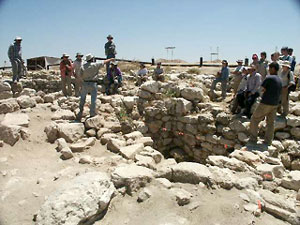 Fridays have become the day for visiting the Fields so we can all be up to date on the most recent discoveries. Fields A and B warmly (it was in the mid 90s at noon) welcomed excavators to visit and view their buildings and other features. John Lawlor (Cornerstone University) held forth in Field A and Kent Bramlett (Walla Walla College) in Field B.
Fridays have become the day for visiting the Fields so we can all be up to date on the most recent discoveries. Fields A and B warmly (it was in the mid 90s at noon) welcomed excavators to visit and view their buildings and other features. John Lawlor (Cornerstone University) held forth in Field A and Kent Bramlett (Walla Walla College) in Field B.
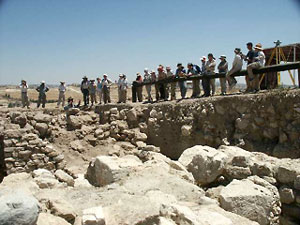
It's a restful Friday evening. The soft evening breeze is calling us to go outside and enjoy the courtyard as it gets dark, watching our two owls fly from tree to tree.
Tomorrow we head for the glories of Petra. That's always a fabulous experience.
